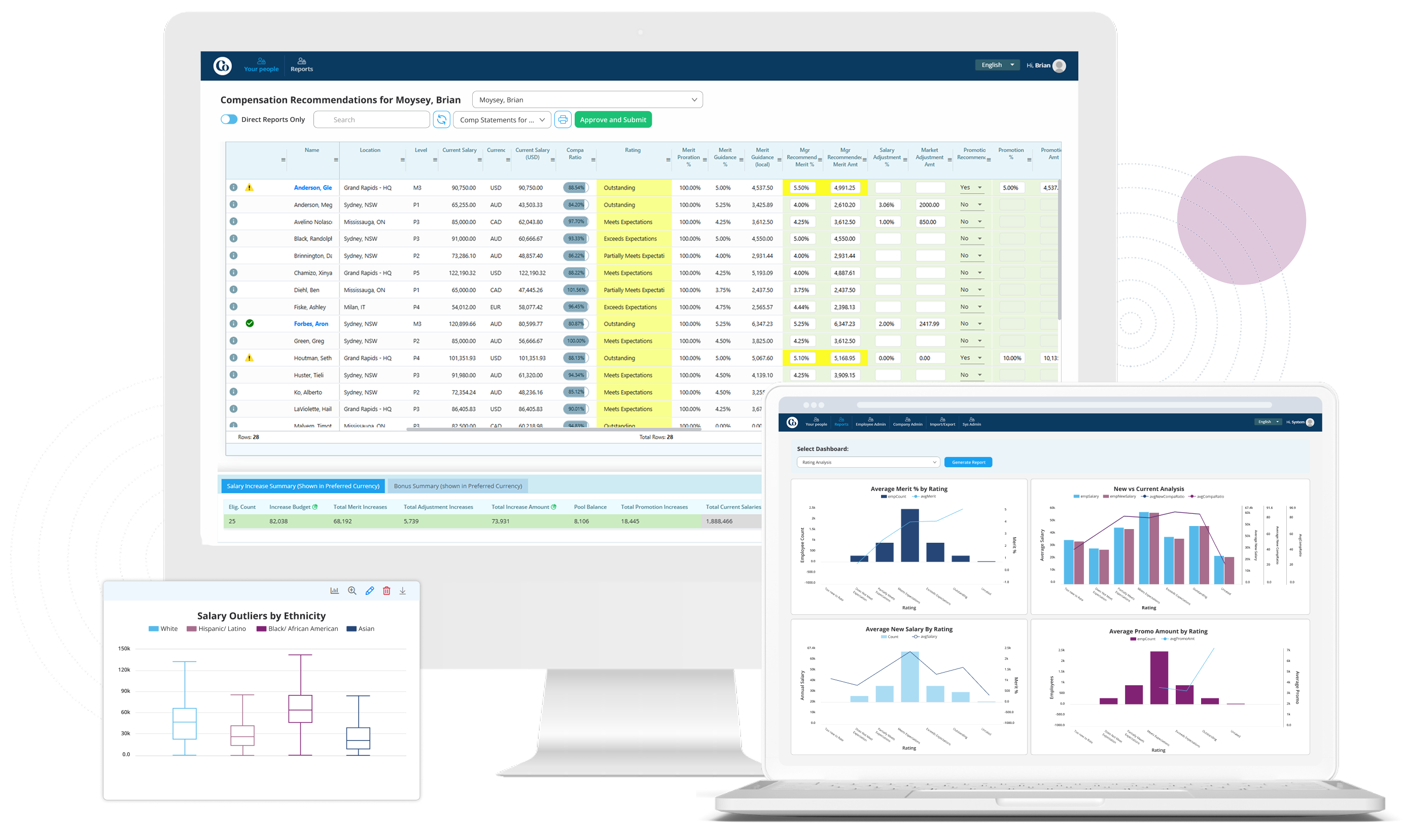Does your organization boast “competitive pay and benefits” in job descriptions, but find applicant numbers and retention rates are falling? If so, the salaries you’re offering may not be as competitive as you think. There’s only one way to find out for sure, and that’s with a compensation analysis.
Compensation analysis is a tool every HR team needs in their strategic toolkit. Pay impacts every corner of your organization — from employee satisfaction and company culture to talent acquisition and turnover. Getting it right ensures fairness, builds trust, and enhances your ability to attract and retain top talent.
Find out how your compensation plans stack up in the market and ensure you’re paying employees what they deserve. You’ll learn how to evaluate market trends, analyze internal pay equity, and link compensation to performance metrics. Refine your pay practices and elevate your organization’s competitive edge with a compensation analysis.
What Is Compensation Analysis?
A compensation analysis is a thorough assessment of your company’s employee pay structure and benefits packages. It’s a process that evaluates how your compensation management strategy — from salaries to bonuses to health benefits — stacks up internally and against competitors.
By gathering both internal and external data, a compensation analysis helps answer one crucial question: Are you paying employees fairly and competitively for their contributions?
Compensation analysis is more than just comparing numbers — it goes beyond the surface to give you deep insight into how pay decisions are made at your organization. Uncover gaps or inconsistencies in pay practices and stay in line with labor market trends. This process helps everyone understand the full context behind compensation decisions.
Factor as much data as possible into your analysis for an accurate understanding of your compensation practices, including:
- External data: Use industry standards and salary benchmarks from similar companies and roles to see where your pay stands in the market.
- Internal data: Analyze current pay information for your employees, factoring in job titles, responsibilities, certifications, and seniority levels.
- Region: Take into account the areas where your employees live — geographic differences can significantly impact salaries.
- Seniority: Identify roles as entry-level, mid-level, senior, or executive since compensation levels often vary widely based on experience and tenure.
- Employee Benefits: Consider health care, retirement plans, vacation time, and other perks as part of your total compensation package.
Compensation analysis gives your HR team and leaders the tools to make informed, data-driven decisions that support workforce satisfaction, business growth, and compliance with pay transparency expectations. It’s a strategic initiative that lays the groundwork for equitable and competitive pay practices across the organization.
Why Should HR Teams Conduct a Compensation Analysis?
You may not notice any dramatic changes in retention or widespread dissatisfaction that would signal a need for a compensation analysis. But why wait for a distress signal to reevaluate this essential strategy? We’ve seen plenty of evidence that proactive preparation puts teams in a better position to weather uncertainty than reactive pivoting.
There aren’t many facets of people management untouched by change over the past few years, and employee pay is no exception. Compensation trends have faced major shifts since 2020. Hiring freezes, layoffs, and salary reductions were commonplace, only to be followed by the Great Resignation, where high turnover drove salaries sky-high.
Now, as the market cools, we’re seeing more changes. Pay transparency laws are becoming the norm. HR teams need to build compensation management strategies for the multigenerational workforce as five, sometimes six, generations work side-by-side.
All of these changes emphasize one thing: compensation management is never static. It evolves along with economic trends, labor laws, and employee expectations. A compensation analysis is your opportunity to ensure your pay practices keep pace with this evolution.
Here’s why regular compensation analysis matters:
- Competing for Top Talent: Stay on top of your strategy and you can create reliable salary benchmarks that help you recruit better talent and retain more of it.
- Ensuring Pay Equity: Pay equity is a legal requirement in many places, but more importantly, it’s a foundational part of a positive work culture. An analysis helps you uncover and close any gaps that could erode employee trust.
- Align Compensation With Business Goals: When salary decisions are tied to performance, budget, and business objectives, you create a more cohesive compensation strategy.
- Prepare for the Future: Change is inevitable, and proactive comp analysis helps you adapt to changes — whether that’s new legislation, economic shifts, or different workforce needs — fast.
Even without any volatility, staying ahead of compensation trends ensures your team isn’t playing catch-up when challenges arise and shows employees that their value is more than a line item on a spreadsheet.
How To Do a Compensation Analysis: 6 Steps
Compensation analysis doesn’t need to be an overwhelming task. Make it manageable by following these actionable steps.
1. Gather Relevant Data
First, start by collecting the data you’ll need for the analysis. (This is a breeze if you’re using compensation management software.) You’ll need internal information like current salaries, job descriptions, and employee performance metrics, as well as external data, such as industry salary benchmarks and market trends. Gather as much data as possible to create a strong foundation for an accurate analysis.
2. Define Your Scope and Objectives
What do you want to accomplish with this compensation analysis? Are you looking to establish benchmarks for roles against market averages? Address pay equity concerns? Reduce new hire turnover?
Start with clear goals to keep your analysis focused and actionable.
3. Assess Internal Pay Equity
Internal equity is just as important as external. Review how salaries compare within your organization. Look for discrepancies between employees in similar roles or demographics, like gender or location. Identify and address any gaps you find to build trust and guarantee fairness.
4. Benchmark Against the Market
Use salary surveys, labor market reports, and industry data to compare your pay to the external market. Pay special attention to roles where turnover is high or hiring has been a challenge — these may be areas where you need to adjust pay and benefits packages.
5. Consider Total Compensation
Compensation isn’t just about base pay. Include bonuses, benefits, equity, and perks in your analysis to get a full picture of what employees are earning and how it compares to competitors’ offerings.
6. Take Action and Communicate Results
After completing the analysis, be prepared to take immediate action. Adjust salary ranges, update compensation policies, and address disparities as soon as possible. Transparency is key here — share updates with leadership and, when appropriate, employees.
Compensation Analysis Without the Guesswork
Compensation analysis doesn’t have to be a daunting task. With the right tools, it becomes a straightforward and powerful way to stay competitive, ensure pay equity, and keep your team motivated. Make it an ongoing strategy that drives fairness, transparency, and trust across your organization with ClearCompany.
Our Compensation Management software with built-in analytics takes the complexity out of the process with automated data collection, benchmarking, and analysis. You’ll spend less time crunching numbers and more time making impactful decisions. Whether you’re refining an outdated pay structure or gearing up for future growth, ClearCompany gives you the confidence and clarity to nail your compensation strategy.
Why wait? Schedule a demo today and see how ClearCompany can help you deliver fair, competitive pay without breaking a sweat. Your employees (and your bottom line) will thank you.


